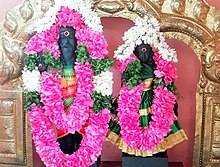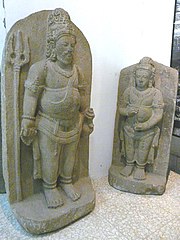Natural Medicinal Scientist, Siddhar
Agastya was a revered Indian sage of Hinduism. In the Indian tradition, he is a noted recluse and an influential scholar in diverse languages of the Indian subcontinent. He and his wife Lopamudra are the celebrated authors of hymns 1.165 to 1.191 in the Sanskrit text Rigveda and other Vedic literature.
Agastya is considered to be the father of Siddha medicine. Agastya appears in numerous itihasas and Puranas including the major Ramayana and Mahabharata.
He is one of the seven most revered rishis (the Saptarishi) in the Vedic texts, and is revered as one of the Tamil Siddhar in the Shaivism tradition, who invented an early grammar of the Old Tamil language, Agattiyam, playing a pioneering role in the development of Tampraparniyan medicine and spirituality at Saiva centres in proto-era Sri Lanka and South India.
He is also revered in the Puranic literature of Shaktism and Vaishnavism.He is one of the Indian sages found in ancient sculpture and reliefs in Hindu temples of South Asia, and Southeast Asia such as in the early medieval era Shaiva temples on Java Indonesia. He is the principal figure and Guru in the ancient Javanese language text Agastyaparva, whose 11th century version survives.
Agastya is traditionally attributed to be the author of many Sanskrit texts such as the Agastya Gita found in Varaha Purana, Agastya Samhita found embedded in Skanda Purana, and the Dvaidha-Nirnaya Tantra text.
He is also referred to as Mana, Kalasaja, Kumbhaja, Kumbhayoni and Maitravaruni after his mythical origins.

Sage Agastya in seated posture. This sculpture is from Angkor period, Cambodia, c. 975 CE.
There are several theories about the etymology of the name "Agastya". One theory connects it to the Sanskrit word "Aj" or "Anj" which means "brighten" and links Agastya to the star Canopus, known for its brightness in South Asian skies. Another theory suggests it is related to the Iranian word "gasta" which means "sin" or "foul", with "a-gasta" meaning "not sin" or "not foul". A folk etymology mentioned in the Ramayana connects it to the roots "aga" meaning "unmoving" or "mountain" and "gam" meaning "move", implying that Agastya is "mover-of-mountains" or "mover-of-the-unmoving". The name is also written as Agasti and Agathiyar.

Maharishi Agastya and Lopāmudrā
Agastya is a celebrated sage in Hindu mythology, believed to have been born from a mud pitcher that contained the semen of gods Varuna and Mitra, and raised by the celestial apsara Urvashi. He is believed to have been a Tamil Brahmin who led an ascetic life and educated himself. Agastya proposed to princess Lopamudra, who later became his wife and bore him a son named Drdhasyu. The location of Agastya's hermitage (ashram) is mentioned in various Indian texts, but the stories are inconsistent and provide different locations in different regions of India
A 12th-century statue of Agastya from Bihar.

Agastya is a revered sage in Hindu mythology and is mentioned in various Hindu texts such as the Ramayana, Mahabharata, and Puranas. In the Ramayana, he is described as a sage who has extraordinary powers and can accomplish what even gods find impossible. He is also known for his role in killing demons Vatapi and Ilwala and lowering the Vindhya mountains. Agastya is described as being short and heavy in build but balances the powers of Shiva and the weight of Kailasha and Mount Meru.
In the Mahabharata, Agastya's story is told in a conversation between Yudhishthira and Lomasa. He is also described as having the power of ingestion and digestion and stops the Vindhya mountains from growing.
The Puranic literature has numerous stories about Agastya, with his biography being told in chapter 61 of the Matsya Purana, chapter 22 of Padma Purana, and other Maha Puranas. In some Puranas, he is listed as one of the Saptarishis or one of the eight or twelve extraordinary sages of Hindu traditions.
The names and details vary across different Puranas and manuscript versions of the same Purana. Agastya is revered in all major Hindu traditions, including Shaivism, Shaktism, and Vaishnavism, and is mentioned in lengthy accounts of the descendants of Agastya and other Saptarishis.
Agastya is a figure in both Northern and Southern Indian traditions, with similarities and differences between the two. Both traditions agree that Agastya migrated from north to south. However, Northern legends focus on his role in spreading Vedic tradition and Sanskrit, while Southern traditions emphasize his role in spreading irrigation, agriculture, and augmenting the Tamil language.
There are different stories about Agastya's ancestry, with Northern traditions describing him as born from a mud pitcher, while Southern traditions reference his descent from a pitcher and his leadership of a migration of tribes from Dvārakā to the south. Some scholars question the historical accuracy of these stories, while others believe they may contain some truth. In Tamil Hindu traditions, Agastya is revered as the first Siddhar, or accomplished master, who perfected his knowledge of the natural and spiritual worlds.

Lobamudra sameda Agasthiyar Temple, A. Vallalapatti, Madurai
Agastya is a revered siddhar in both philosophical and practical domains and is unique for his widespread reverence across the Indian subcontinent. While most other siddhar are revered for their specific domain of knowledge, Agastya, along with Tirumular, is considered a master in both domains.
The earliest mentions of Agastya in medicine siddhar Tamil texts are from the 15th century, according to Venkatraman and Hartmut Scharfe. However, some consider the writer of these texts to be a different person and that the sage Agastya, Akattiyan the Siddha, and Akatthiyar, the author of Akattiyam, were three or possibly four different persons of different eras that became fused into one single person in the Tamil tradition.
Agastya is also mentioned in several Buddhist texts, and in Tamil texts, he is described as the sage who learned Tamil and Sanskrit grammar and poetics from Avalokitan, another name for the Buddha-to-be Avalokiteśvara.

The Agastya is often depicted as a divine sage of Shaivism, holding Shiva's trident, and can be seen in statues at southeast Asian temples. He is also referenced in South Indian texts like the Manimekalai and Viracoliyam, where he is portrayed as a student of the Buddha-to-be. In Buddhist mythology, he appears in Jataka tales, and is featured in the seventh chapter of the Jataka-mala by Aryasura, a text about the Buddha's previous lives. The Agastya-Jataka story is even carved as a relief in the Borobudur, a large Mahayana Buddhist temple from the early medieval era.

Agastya is a common figure in medieval Shiva temples of Southeast Asia, including those in Java. Many of these temples feature sculptures or reliefs of Agastya on their southern faces, along with other icons of Shiva, Uma, Nandi, and Ganesha that face specific cardinal directions. The largest Hindu temple complex in Southeast Asia, Prambanan, has a central shrine with four cellae, one of which is dedicated to Agastya. The Dinoyo inscription, dated to 760 CE, is mainly dedicated to Agastya and suggests that the reverence for his iconography in Southeast Asia dates back to an earlier period. Additionally, the 9th-century king Indravarman of Cambodia is said to be a descendant of Agastya in contemporary texts

The Ranganathaswamy Temple in Srirangam, India, houses a statue of the Singing Sage or Sage Agastya playing a veena. Agastya is a revered figure in Tamil Nadu, with temples dedicated to him located in various parts of the state, including the Sri Agasthiyar Temple at Agasthiyar Falls and the Sri Lobamudra Samedha Agasthiyar Temple in A. Vellalapatti. Agastya statues or reliefs can also be found in many ancient temples across North India, South India, and Southeast Asia.
Agastya is often depicted holding a pitcher, with or without a potbelly, receding hairline, dagger, or sword. He is also sometimes portrayed as a guardian at the entrance of temples. Agastya is associated with the Pothigai hill source of the river, as mentioned in epics such as Silappatikaram and Manimekhalai, and a shrine dedicated to him is located on or near Adam's Peak in Sri Lanka.
Maharishi Agastya is also credited with founding the martial art of Silambam in Tamil Nadu and the ancient science of healing using varmam points for various diseases, which is utilized by practitioners of the southern form of Kalaripayattu in Kerala. According to legend, Agastya learned varmam from Murugan, the son of Shiva, and passed on his knowledge through treatises to other siddhars.